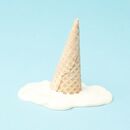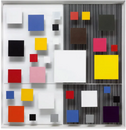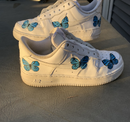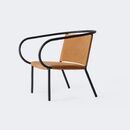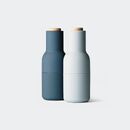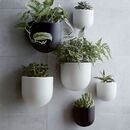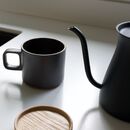Minimalism refers to a lack of clutter or unnecessary detail. It has had a widespread influence, ranging from the arts to lifestyle.
As an art movement, Minimalism began in post-WWII Western art, and was most prominent in the 1960s through the early 1970s. It is strongly influenced from the reductive aspects associated with some parts of Modernism, including Suprematism, Purism, and De Stijl.
The art movement has had a significant influence on Minimalism as a lifestyle, which is a rejection of consumerist trends with an emphasis on simple living. This lifestyle has become increasingly prominent since 2010, and is commonly associated with The Minimalists.
Historic precedents[]
For most history, Maximalism was mainstream for high end art, design and architecture. At the same time, peasants and most of the population which wasn't part of the elite owned simple objects and lived in basic homes, which to our eyes of today might look 'Minimalistic'. Aside from financial factors, across time, in some circumstances minimalism occurred before Modernism.
Probably the most famous case is the one of Ancient Egyptian pyramids. Both their exteriors and interiors were simplistic. In the case of the Pyramids of Giza, they were initially covered in a layer of smooth white limestone, and their tops were covered in gold. What we see today is the core structure, since the surface polished limestone layer was used to build the city of Cairo during the Middle Ages. Another form of ancient Minimalism was the exterior of Byzantine buildings, especially churches. Because Christian liturgies are held in the interior of the churches, Byzantine exteriors usually have little if any ornamentation. Still produced today, admired and collected by many Minimalists are simple Japanese ceramics. Across time, both sophisticated highly decorated porcelain and simple everyday ware were produced in Japan. These simple Japanese pots, coloured in earthy tones, inspired many Art Nouveau ceramists and glass makers during the 1890s and the 1900s. Precisionism was an art movement in the United States after World War I and it also incorporated design principles that would be popular later on with Minimalism, such as depicting the world in a reduced and minimal form.
Visuals[]
Minimalism refers to a lack of clutter. This means that visuals tend to be very simple and remove unnecessary details. Solid colors are very common. Simple patterns may also appear; anything that is complex will not. Colors also tend to be very muted.
Artists[]
- Carl Andre
- Anthony Caro
- Dan Flavin
- Al Held
- Donald Judd
- Ellsworth Kelly
- Sol LeWitt
- Agnes Martin
- John McCracken
- Robert Morris
- Kenneth Noland
- Robert Ryman
- David Smith
- Tony Smith
- Frank Stella
- Anne Truit
Fashion[]
Minimal fashion is simple and quiet and doesn't have bold and bright colours like other aesthetics. Some aspects of the fashion may include:
- Solid-color t-shirts (typically white or grey)
- Collared shirts
- Button-up shirts
- Belts
- Khaki or black pants
- Jeans
- Other related aesthetics: Vanilla Girl, Clean Girl
Subgenres[]
Indie Minimalism[]
Indie Minimalism is an independent aesthetic that's based on minimalist design, individualism, urban life, music, and the arts. As the name implies, it blends elements of the Indie aesthetic along with the otherwise Minimalist aesthetics.
Colors[]
The color palette is usually based around white, black, navy, and light gray or blue, with one or two bright accents. Also, the minimalism side is heavily influenced by the bright colors and clean lines of Bauhaus and Modernist design.
Fashion[]
Indie style means basically just whatever feels right based on your personal aesthetic, and usually involves avoiding mainstream labels. Minimalism is just what it sounds like: a little. This often means a spare, neutral palette, clean lines, and a focus on function and practicality first. So, indie minimalism is a combination of these styles, usually involving basics like a white button-down shirt or jeans outfits with one or two distinctive touches of color. You can get inspiration from urban street-style (as long as you are dressing for yourself rather than to show off to others) or find clothes in thrift shops and vintage stores if you like to shop.
Brands[]
Activities[]
- Photography
- Watching or producing independent films
- Listening to indie music (Independently released music is not directly financially dependent on any of the four major labels (WMG, Sony BMG, EMI and Universal. "Indie" does not refer to a style of music; it refers to the financial circumstances of its distribution.)
Resources[]
A list of external links to help get a better understanding of this aesthetic.
Instagram[]
Pastel Minimalism[]
Pastel Minimalism combines pastel colors with small, ordinary subject matter or simple architecture. The most common examples of Pastel Minimalism are in stock photos. This aesthetic's purpose may be to give Minimalism a splash of color.
Resources[]
A list of external links to help get a better understanding of this aesthetic.
Pinterest Boards[]
- aes | Pastel Minimalist by Nicole
- Pastel Minimalist by Ariel Griffin
- Pastel minimalist by Cleogermain
- Pastel Minimal by Kirstie Schults
- Minimalism Pastel by pastelbanana
Matcha Minimalism[]
Matcha Minimalism is a design aesthetic centering around simple, well-designed everyday objects that convey an understated warmth.
It places an emphasis on ritualized experience, sensory attentiveness, and tranquility. It can be described as clean, light, simple, functional, and minimal.
Matcha often employs the use of a single muted color, or a muted color palette, against a white or black backdrop. Common materials include brushed metal, wood, paper, matte plastic, cork, felt, and ceramic.
Matcha design encourages sensory specificity as a means to turning daily experiences into pleasing rituals. Accordingly, it overlaps with some vintage technologies whose daily usage conjures sounds, smells, and textures (eg. vinyl record albums, cassette tapes, mechanical typewriters, and paper stationery).
Typographic elements are carefully crafted in Matcha design, and often feature as part of, rather than simply accessory to, the overall design of an object.
Matcha draws from the simplicity of minimalism, but places an added emphasis on sensory delight. While it shares some elements with Comfy/Cozy, including a ritualized ease in daily activities, it is not confined to a set of behaviors. Similarly, it overlaps with the warmth of Coffee House, but with an added emphasis on the experience of objects in themselves, and not simply as part of a larger environment. Technozen is a subcategory of it, which is associated with with Mid 2000s music and technology and has a more restrictive color palette.
Stores & Brands[]
Visual Arts[]
Music[]
Activities[]
- Making tea or coffee
- Drinking tea or coffee
- Typing on the computer
- Reading a book
- Tidying a room
- Lighting a candle
- Putting on a vinyl record
Criticism[]
Sterility and lack of personality[]
Critics argue that minimalist spaces can sometimes feel cold, sterile, and devoid of personal expression. The emphasis on clean lines and neutral colors may result in an environment that lacks warmth and character, leading to an impersonal and unwelcoming atmosphere.
Lack of functionality[]
In some cases, minimalism may prioritize aesthetics over functionality. By reducing possessions and focusing on simplicity, minimalism may overlook the practical needs and preferences of individuals. This can result in sacrificing comfort, convenience, and personal enjoyment in the pursuit of an idealized minimalist lifestyle.
Emotional detachment[]
Minimalism's emphasis on decluttering and detachment from material possessions can be seen as a detachment from emotional attachments as well. Critics argue that sentimental objects and personal belongings play a significant role in our lives, connecting us to memories and experiences. By minimizing the importance of these items, minimalism may overlook the emotional value they hold for individuals.
Media[]
Film[]
- Less is Now (2021)
- Minimalism (2015)
Youtube[]
These are Youtubers who frequently talk about minimalism and related topics.
Books[]
- The Joy of Less by Francine Jay (2010)
- The Life-Changing Magic of Tidying Up by Marie Kondo (2010)
- While not strictly minimalist, her book (and philosophy) have been a gateway to minimalism for many people.
- Love People Use Things by Joshua Fields Millburn & Ryan Nicodemus (2021)
- Everything That Remains by Joshua Fields Millburn & Ryan Nicodemus (2014)
- Less Than Zero by Bret Easton Ellis (1985)
- Minimalism by Joshua Fields Millburn & Ryan Nicodemus (2011)
- Essential by Joshua Fields Millburn & Ryan Nicodemus (2012)
- Goodbye, Things by Fumio Sasaki (2015)
Music[]
- La Monte Young
- Terry Riley
- Steve Reich
- Philip Glass
- Julius Eastman
- John Adams
- Palette, IU (Feat. G-DRAGON)
Playlists[]
- The Sound of Minimal Wave Spotify playlist by The Sounds of Spotify
- illbient/minimal Spotify playlist by jennrock
- Minimalism Official Spotify Playlist
- Minimal Music Spotify playlist by Sony Classical Benelux
- minimalist music (no lyrics) Spotify playlist by Firefly
- Minimal Spotify playlist by Pertra
Podcasts[]
- Millenial Minimalists (2019-)
- Minimal-ish: Realistic Minimalism (2018-)
- The Minimalists (2016-)
- The Sustainable Minimalists (2018-)
Resources[]
Blogs[]
Vendors[]
Pinterest boards[]
- MINIMAL (interior design)
- Minimal (fashion)
- Minimalism (art)
- [minimal]





























